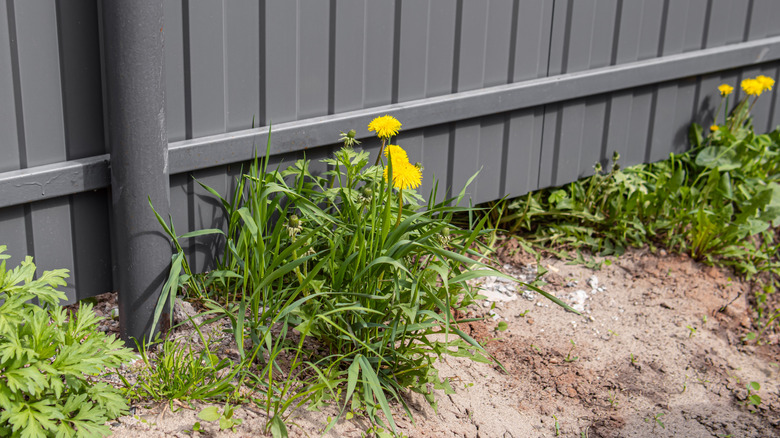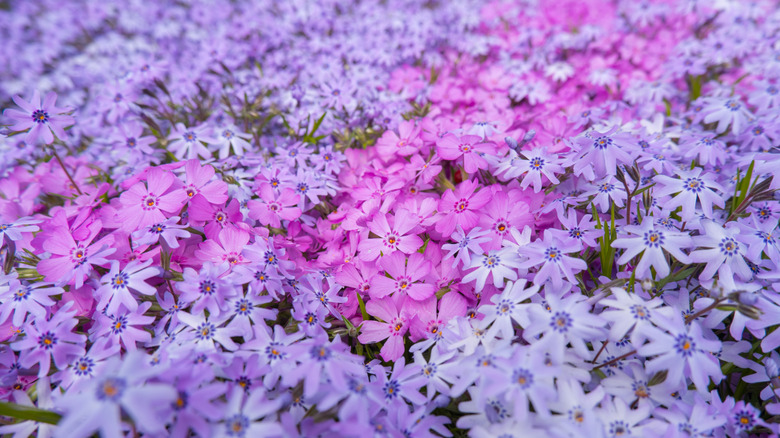Stop Invasive Weeds From Next Door With These Hardy Garden Plants
Controlling invasive weeds that make their way into your landscape, whether by milkweed floating over your fence, sneaky underground rhizomes, or birds seed-bombing your yard, doesn't belong on anyone's gardening to-do list. Before taking extreme measures, or spending all of your weekends weeding and mulching your yard, consider crowding your neighbor's trespassers out by adding hardy alternatives to your garden, such as beautiful ground covers or wonderfully clumping grasses.
A hardy ground cover that's an alternative to a grass lawn attracts pollinators to your landscape and tough grasses help keep invading weeds at bay. Choose plants or grasses that match the cultural conditions of your yard and climate. Is your yard in full sun for most of the day? Is your region rainy or droughty or in between? Other things to consider are how much maintenance you have time for, or whether starting a pollinator garden is part of your plan, and the type of plants that thrive in your soil.
Hardy ground cover flowering plants that crowd out invasive weeds
Creeping phlox (Phlox subulata) forms dense mats of foliage with colorful flowers that bloom in the spring. Hardy in USDA zones 3 through 9, this low, perennial ground cover thrives in full or dappled sun and acidic, well-drained soil. Each plant forms a thick clump about 6 inches tall and 2 to 3 feet wide. Cutting the phlox back after it blooms encourages denser growth.
There are more than 900 species of salvia (Salvia spp.), most with vivid flowers and some with scented foliage. While there are low-growing varieties, some grow rapidly, reaching 6 feet tall in a single growing season. Full sun and well-drained, slightly acid soil encourages the continuous production of flowering spikes. Bedding sage (Salvia splendens), one of the most popular species, is hardy in zones 10 to 11, and grows 8 to 30 inches tall.
Unlike its invasive cousin — Japanese pachysandra (Pachysandra terminalis) — Allegheny spurge or mountain pachysandra (Pachysandra procumbens) won't outcompete the other plants in your garden. Once established in zones 4 through 9, this evergreen ground cover forms a dense carpet, even under trees. Pink or white blossoms appear on 2 to 4 inch spikes in early spring. Allegheny spurge grows 6 to 10 inches tall and likes moist, well-drained, acidic soil.
Tough grasses that keep invasive weeds at bay
Little bluestem (Schizachyrium scoparium), also known as prairie beardgrass, is a clumping, warm season grass hardy in zones 3 through 9. Clumps of foliage appear bluish in the summer and copper in the fall and winter, and grow up to 4 feet tall and 3 feet wide. While little bluestem does best in moist, well-drained soil in a sunny location, it tolerates most soil conditions. Cut the grass back in late fall or early spring to promote growth.
Zoysiagrass (Zoysia spp.) forms a dense lawn that weeds have a hard time competing with. Hardy in zones 5 through 11, zoysia does best in moist, well-drained soil and full sun. Meyer, an improved variety of Zoysia japonica, is touted as a supergrass because of its rapid spread and tolerance for cold. Because zoysia typically grows slowly, it doesn't need to be mowed as frequently. But, keep in mind that once it's established, zoysia is hard to get rid of.


